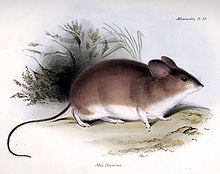Phyllotis
| Phyllotis Temporal range: Pleistocene - Recent
| |
|---|---|

| |
| Darwin's leaf-eared mouse (Phyllotis darwini) | |
| Scientific classification | |
| Domain: | Eukaryota |
| Kingdom: | Animalia |
| Phylum: | Chordata |
| Class: | Mammalia |
| Order: | Rodentia |
| Family: | Cricetidae |
| Subfamily: | Sigmodontinae |
| Tribe: | Phyllotini |
| Genus: | Phyllotis Waterhouse, 1837 |
| Type species | |
| Mus darwini | |
| Species | |
|
Phyllotis alisosiensis | |
Phyllotis is a genus of rodent in the family Cricetidae.[1] These mice are commonly confused with Auliscomys, Graomys and Loxodontomys. [2]. In order to tell these genera apart, one must look at the tail. Species in the genus Phyllotis have a penicillate tip on their tail which is not present in the other two genera. Tails in the genus Phyllotis are also less than the length of its head and body combined whereas in Graomys, tails are longer than the head and body combined .[2] Phyllotis xanthopygus was found at the summit of Volcán Llullaillaco (6739 m), which is the highest altitude a mammal has yet been found in nature.[3][4]
It contains the following species:
- Los Alisos leaf-eared mouse (Phyllotis alisosiensis)
- Friendly leaf-eared mouse (Phyllotis amicus)
- Andean leaf-eared mouse (Phyllotis andium)
- Anita's leaf-eared mouse (Phyllotis anitae)
- Buenos Aires leaf-eared mouse (Phyllotis bonariensis)
- Capricorn leaf-eared mouse (Phyllotis caprinus)
- Darwin's leaf-eared mouse (Phyllotis darwini)
- Definitive leaf-eared mouse (Phyllotis definitus)
- Gerbil leaf-eared mouse (Phyllotis gerbillus)
- Haggard's leaf-eared mouse (Phyllotis haggardi)
- Lima leaf-eared mouse (Phyllotis limatus)
- Master leaf-eared mouse (Phyllotis magister)
- Osgood's leaf-eared mouse (Phyllotis osgoodi)
- Bunchgrass leaf-eared mouse (Phyllotis osilae)
- Pearson's leaf-eared mouse (Phyllotis pearsoni)
- Pehuenche leaf-eared mouse (Phyllotis pehuenche)
- Punta de Vacas leaf-eared mouse (Phyllotis vaccarum)[5]
- Wolffsohn's leaf-eared mouse (Phyllotis wolffsohni)
- Yellow-rumped leaf-eared mouse (Phyllotis xanthopygus)
References
- ^ Wilson, D. E.; Reeder, D. M., eds. (2005). Mammal Species of the World: A Taxonomic and Geographic Reference (3rd ed.). Johns Hopkins University Press. ISBN 978-0-8018-8221-0. OCLC 62265494.
- ^ a b Kramer, Kristin M.; Monjeau, J. Adrian; Birney, Elmer C.; Sikes, Robert S. (1999). "Phyllotis xanthopygus" (PDF). Mammalian Species (617): 1–7. doi:10.2307/3504375. JSTOR 3504375.
- ^ Storz, J.F., Quiroga-Carmona, M., Opazo, J.C., Bowen, T., Farson, M., Steppan, S.J., and D’Elía, G. (2020). Discovery of the world’s highest-dwelling mammal. BioRxiv 2020.03.13.989822.
- ^ Barras, Colin (19 March 2020). "World's highest mammal discovered at the top of a Mars-like volcano". New Scientist. Retrieved 22 March 2020.
- ^ "Phyllotis vaccarum O. Thomas, 1912". The Mammal Diversity Database.
